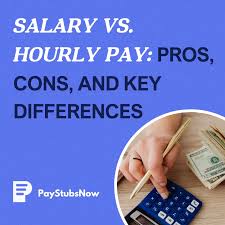Hourly vs Salary Pay Stubs: Basics for US Employees (2025 Guide)
Introduction: Why Hourly vs Salary Pay Stubs Matter
Every US employee, whether paid hourly or on a salary, receives a pay stub explaining how their earnings are calculated. Understanding hourly vs salary pay stubs is critical for financial planning, tax reporting, and transparency. This 2025 guide explores the basics of both pay structures, highlights their differences, and provides insights to help employees and employers manage payroll effectively. For more guidance, see our Regular Pay Stub overview.
What Is a Pay Stub?
A pay stub, sometimes called a paycheck stub, is a detailed breakdown of wages for a specific pay period. It typically shows:
- Gross Pay: Total wages before deductions
- Deductions: Taxes, insurance, retirement, and other contributions
- Net Pay: Take-home pay after all withholdings
Employers provide pay stubs digitally or in print depending on state law. Employees and freelancers can also generate accurate pay stubs using a Pay Stub Generator.
Hourly Pay Stubs Explained
An hourly pay stub reflects pay based on hours worked. Each pay period includes the hourly rate, total hours, and overtime hours.
Key Features of Hourly Pay Stubs
- Hourly Rate: Defined in the employment contract
- Total Hours Worked: Regular and overtime hours tracked separately
- Overtime Pay: Typically 1.5× or 2× the rate per state law
- Deductions: Standard taxes and voluntary contributions
- Net Pay: Variable based on hours worked
Hourly pay stubs are important for part-time, seasonal, or shift-based workers due to fluctuating hours. Learn more about managing hourly payroll on our Hourly Pay Stub Guide.
Salary Pay Stubs Explained
Salary pay stubs reflect fixed annual pay divided into regular pay periods. Employees generally receive the same gross pay each cycle, regardless of hours worked.
Key Features of Salary Pay Stubs
- Fixed Salary: Annual compensation divided across pay periods
- Consistent Paychecks: Predictable for budgeting
- Deductions: Taxes, insurance, retirement contributions
- Net Pay: Stable unless bonuses or adjustments occur
Salaried employees enjoy income stability, but extra hours may not reflect on the stub unless contractually agreed.
Hourly vs Salary Pay Stubs: Key Differences
While both include gross pay, deductions, and net pay, they differ in calculation and transparency:
| Aspect | Hourly Pay Stub | Salary Pay Stub |
|---|---|---|
| Pay Basis | Hours worked × hourly rate | Annual salary ÷ pay periods |
| Overtime | Shown when exceeding 40 hours/week | Rarely shown unless agreed |
| Income Stability | Variable | Consistent |
| Transparency | Detailed hours and rates | Simple summary of earnings |
Legal Requirements in the US
State laws vary:
- California: Itemized statements with hours, rates, and deductions
- New York: Detailed pay statements required
- Texas: Pay stubs not legally required but commonly issued
- Illinois: Written or electronic stubs required each payday
Employees should keep pay stubs at least three years for taxes, disputes, or loan applications.
Pros and Cons
| Type | Pros | Cons |
|---|---|---|
| Hourly | Transparency, overtime potential | Variable income, fluctuating paychecks |
| Salary | Stable, predictable, easier budgeting | No overtime unless specified, potential unpaid extra hours |
Reading Your Pay Stub
- Check employee information: name, pay period, employer details
- Review gross pay: hourly or salary-based
- Examine deductions: taxes, insurance, retirement
- Verify net pay against your bank deposit or check
Using a regular pay stub sample can make this process easier.
Using a Pay Stub Generator
Manual stub creation can lead to errors. A pay stub generator produces accurate, professional stubs in minutes, ideal for small businesses, freelancers, and contractors.
Conclusion
Understanding hourly vs salary pay stubs is essential for financial management. Hourly pay stubs offer transparency and overtime tracking, while salary stubs provide stability and predictable pay. By reviewing stubs regularly, keeping records, and using tools like a Pay Stub Generator or a Regular Pay Stub, employees and employers can ensure payroll accuracy, legal compliance, and financial control in 2025.

